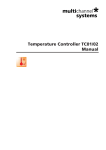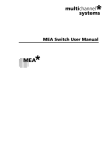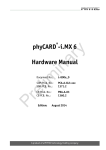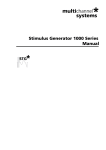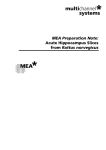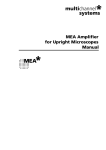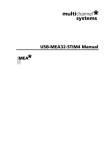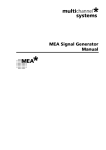Download TC01/2 User Manual
Transcript
TC01/2 User Manual Information in this document is subject to change without notice. No part of this document may be reproduced or transmitted without the express written permission of Multi Channel Systems MCS GmbH. While every precaution has been taken in the preparation of this document, the publisher and the author assume no responsibility for errors or omissions, or for damages resulting from the use of information contained in this document or from the use of programs and source code that may accompany it. In no event shall the publisher and the author be liable for any loss of profit or any other commercial damage caused or alleged to have been caused directly or indirectly by this document. © 2002 Multi Channel Systems MCS GmbH. All rights reserved. Printed: 05.12.2003 Multi Channel Systems MCS GmbH Aspenhaustraße 21 72770 Reutlingen Germany Fon +49-71 21-90 92 5 - 0 Fax +49-71 21-90 92 5 -11 [email protected] www.multichannelsystems.com Products that are referred to in this document may be either trademarks and/or registered trademarks of their respective holders and should be noted as such. The publisher and the author make no claim to these trademarks. Table Of Contents 1 1.1 1.2 Introduction About this Manual Scope of Delivery 1 1 1 2 2.1 2.2 2.3 Important Information and Instructions Operator's Obligations Guarantee and Liability Important Safety Advice 3 3 3 4 3 3.1 3.2 3.3 3.4 Installation and Operation Welcome to the TC0X Setting Up and Connecting the TC0X Operating the TC0X 3.3.1 Starting the TC0X 3.3.2 General User Interface 3.3.3 TC0X menus 3.3.4 Setting a Temperature 3.3.5 Channel Configuration 3.3.6 Error Messages Controlling the TC0X via the RS232 Serial Port 5 5 6 6 6 7 7 8 8 9 10 4 4.1 4.2 4.3 Appendix Technical Specifications D-Sub9 — Pin Assignment Parameter Ranges 13 13 13 13 i 1 Introduction 1.1 About this Manual This manual comprises all important information about the first installation and the proper usage of the temperature controller TC01 and TC02. It is assumed that you have a basic understanding of technical terms, but no special skills are required to read this manual. Make sure you read the "Important Information and Instructions" prior to install or to operate the TC0X. 1.2 Scope of Delivery 1 1 1 1 TC0X main device Main cable Null modem cable User Manual 1 2 Important Information and Instructions 2.1 Operator's Obligations The operator is obliged to allow only persons to work on the device, who • are familiar with the safety at work and accident prevention regulations and have been instructed how to use the device; • are professionally qualified or have specialist knowledge and training and have received instruction in the use of the device; • have read and understood the chapter on safety and the warning instructions in this manual and confirmed this with their signature. It must be monitored at regular intervals that the operating personnel are working safely. Personnel still undergoing training may only work on the device under the supervision of an experienced person. 2.2 Guarantee and Liability The General conditions of sale and delivery of Multi Channel System MCS GmbH always apply. The operator will receive these no later than on conclusion of the contract. Guarantee and liability claims in the event of injury or material damage are excluded when they are the result of one of the following. • Improper use of the device • Improper installation, commissioning, operation or maintenance of the device • Operating the device when the safety and protective devices are defective and/or inoperable • Non-observance of the instructions in the manual with regard to transport, storage, installation, commissioning, operation or maintenance of the device • Unauthorized structural alterations to the device • Unauthorized modifications to the system settings • Inadequate monitoring of device components subject to wear • Improperly executed and unauthorized repairs • Unauthorized opening of the device or its components • Catastrophic events due to the effect of foreign bodies or Acts of God 3 TC0X User Manual 2.3 Important Safety Advice Warning: Make sure to read the following advices prior to install or to use the device. If you do not fulfill the requirements stated below, this may lead to malfunctions, breakage, or even injuries. Warning: Obey always the rules of local regulations and laws. Only qualified personnel should be allowed to perform laboratory work. Work according to good laboratory practice to obtain best results and to minimize risks. The product has been built to the state of the art and in accordance with recognized safety engineering rules. The device may only • be used for its intended purpose; • be used when in a perfect condition. Improper use could lead to serious, even fatal injuries to the user or third parties and damage to the device itself or other material damage. Malfunctions which could impair safety should be rectified immediately. This device is no medical instrument and must not be used on humans. High Voltage • Electrical cords must be properly laid and installed. The length and quality of the cords must be in accordance with local provisions. • Only qualified technicians may work on the electrical system. It is essential that the accident prevention regulations and those of the employers' liability associations are observed. • Each time before starting up, make sure that the mains supply agrees with the specifications of the product. • Check the power cord for damage, each time the site is changed. Damaged power cords should be replaced immediately and may never be reused. • Check the leads for damage. Damaged leads should be replaced immediately and may never be reused. • Do not try to insert anything sharp or metallic into the case. • Do not short-circuit the outputs of the device. • Liquids may cause short circuits or other damage, even could lead to fatal injuries. Keep the device and the power cords always dry. Do not handle it with wet hands. Make sure the device and your experiment are set up in a way that makes it impossible that any liquid spills onto the device or flows into the device from the surface of the table. Requirements for the installation and during operation • The TC0X must be set up on a rigid, vibration-free base. • The connected heating elements produce heat and can get hot during operation. • Do not touch the connected heating elements during operation and do not store flammable materials nearby. • Do not place anything on top of the connected heating elements, and do not place it on top of another heat producing device. • Check in regular intervals that the connected heating element does not overheat. • Regard the specifications of the connected heating element. 4 3 Installation and Operation 3.1 Welcome to the TC0X The temperature controller TC0X is used to regulate a connected heating element. It is available with one or two output channels — TC01 and TC02, respectively. Handling of both devices is similar and information in the TC0X User Manual applies to both. The TC0X is recommended for use with the following products provided by MCS, but you can use it for any custom-made system as well. • MEA1060-1: 60 channel preamplifier and filter amplifier for microelectrode arrays on inverted microscopes • MEA1060-2: 60 channel preamplifier and filter amplifier for microelectrode arrays on upright microscopes • PH01: Perfusion cannula with heater and sensor The TC0X is regulated by a PID based control. The PID coefficients are preset for the MCS products mentioned earlier (see "MCS Default PID Coefficients" in the Appendix). You can modify them to suit your needs. Note: MCS can provide a PID specification for your application on request. The set-point temperature is reached within 30 s to 5 minutes, depending on the system to be regulated and on the PID coefficients. A maximum temperature of 50 °C can be obtained. The accuracy is +/- 0.1 °C. The TC0X heats actively, but the cooling is passive. Therefore, the minimum temperature is defined by the room temperature. A room temperature beyond 10 °C is not recommended. The outputs are isolated against ground, that is, the TC0X does not interfere with your experimental setup. 5 TC0X User Manual 3.2 Setting Up and Connecting the TC0X Provide a power supply in the immediate vicinity of the installation site. 1. Place the TC0X on a stable surface, where the air can circulate freely and the device is not exposed to direct sunlight. 2. Plug the main cable into the socket on the back of the TC0X. 3. Connect the main cable to the power supply. 4. Connect the TC0X to the heating element with the cable that is delivered with the heating system or with your own custom cable. The cable is plugged into the female D-Sub9 socket. (CH1 for channel 1, CH2 for channel 2, if you have a TC02) See also "D-Sub9 Pin Assignment". 3.3 Operating the TC0X 3.3.1 Starting the TC0X → Press the power switch on the TC0X rear panel. The TC0X starts up. The Multi Channel Systems logo appears on the display for a short moment and the blue status lamp on the front panel is switched on. If the TC0X is connected properly, the actual temperature and the set-point temperature are displayed. (TC02: The actual temperature and the set-point temperature of channel 1 appear on the left side of the display, channel 2 on the right side.) If a channel is not connected, the error message "TEMP TOO HIGH OR SBR" appears (see below). 6 Installation and Operation 3.3.2 General User Interface The display shows the actual temperature and the set-point temperature. You can enter the next menu by pressing the Select button. Jump to a parameter with the Up and Down buttons and press Select again to select the blinking parameter and to enter the next menu where you can modify this parameter. The functionality of the button array on the front panel is described in the following. Select: Press this button to select the blinking parameter and go to the next menu. Enter: Confirms and saves the set temperature / PID coefficient / factory default PID coefficients. Up: Jumps to the next right parameter in the main menu or increases the displayed parameter value. Tip once to increase the value in a small single step, press longer for larger steps. Down: Jumps to the next left parameter in the main menu or decreases the displayed parameter value. Tip once to increase the value in a small single step, press longer for larger steps. 3.3.3 TC0X menus Press the Select button to go to the Select Parameter menu or to the Select Channel menu (TC02 only). From the Select Parameter menu, select MCS to go to the MCS-Defaults menu. Select Channel menu (TC02) CH1: Channel 1 CH2: Channel 2 ESC: Back to the temperature display Select Parameter menu T: Change the set-point temperature P: Set the Proportional parameter I: Set the Integral parameter D: Set the Derivative parameter ESC: Back to the temperature display MCS: Select factory default PID coefficients for MCS products (MCS-Defaults menu). MCS-Defaults menu MEA-1: Factory default PID coefficients for MEA1060-1 amplifier for inverted microscopes MEA-2: Factory default PID coefficients for MEA1060-2 amplifier for upright microscopes PH-01: Factory default PID coefficients for PH01 perfusion cannula ESC: Back to the temperature display 7 TC0X User Manual 3.3.4 Setting a Temperature 1. (TC02 only) Press the Select button. The Select Channel menu is displayed. 2. (TC02 only) Press the Up/Down buttons to switch to another channel. 3. Press the Select button. The Select Parameter menu is displayed. The T (for temperature) is blinking, that is, you can select the temperature parameter now. 4. Press Select again. The current set-point temperature is displayed. 5. Modify the displayed value by pressing the Up and Down buttons. 6. When you are finished, confirm the new set-point temperature by pressing Enter. The message "T set to <set-point temperature>" is displayed. Note: If you leave the menu without confirming the changes by pressing Enter, the changes will have no effect. 3.3.5 Channel Configuration PID coefficients are changed in the same way than the temperature. From the Select Parameter menu, select the appropriate coefficient, change it with the Up/Down buttons, and confirm the settings by pressing Enter. We recommend to use the factory-default PID coefficients with MCS products. From the Select Parameter menu, select MCS and then select the product you are using. Confirm the settings by pressing Enter. Example: You are using a MEA1060-2 amplifier for upright microscopes on channel 1, and a perfusion cannula PH01 on channel 2 of a TC02. You now have to configure both channels for these instruments. Select MEA-2 for channel 1 and PH-01 for channel 2 in the MCS Defaults menu of the TC02. Note: The factory default PID parameters have been optimized at an ambient temperature of 25 °C, the PID coefficients for use with the PH01 at a flow rate of 2000 µl/min. You may have to adjust these PID coefficients for your experimental setup, especially if the ambient temperature or the flow rate differ at large from those used by MCS. See also "MCS Default PID Coefficients" in the Appendix. 8 Installation and Operation 3.3.6 Error Messages The following error messages may be displayed under the following circumstances. Note: (TC02 only) For each channel, a separate error message is displayed. For example, if you have connected only the left channel 1, the error message "Temp too high or SBR" is displayed on the right side of the display. On the left side, the actual temperature and set-point temperature of the connected channel 1 are displayed. TEMP TOO HIGH OR SBR This message is displayed if • no heating element is connected; or • the sensor of he heating element does not work; or • the temperature of the heating element is out of range, that means the temperature is higher than 52° C. If this message is displayed, the heating is stopped, until the heating element is connected properly and the temperature is in the range again. TEMP LOW This message is displayed if the temperature drops below 10° C. TEMP HIGH This message is displayed if the temperature is higher than 50° C. (If the temperature exceeds the operating range of 52° C, the message "Temp too high or SBR" is shown. 9 TC0X User Manual 3.4 Controlling the TC0X via the RS232 Serial Port You can read the actual temperature values on your computer and save the data as a text file. You can then import this file into your custom evaluation software, for example to plot a curve. You can also read and change the set-point temperature or modify the PID coefficients by remote control via the serial port. The following instructions show you which parameters are available for each command. An error messages informs you when you have pressed an unknown key combination. Setting up the Terminal Program Connect the serial port of the TC0X to a serial port of your computer. You can control the TX0X with a Terminal program. There are several shareware programs available on the internet. Some settings are important for the communication with the TC0X. Please configure the Terminal program as stated below. If you do not choose to enable the local echo, you will not see the characters you have entered on the screen. Serial port: Port: Com1 or Com2 (or other free Com port) Baudrate: 19200 Data: 8 bit Parity: None Stop: 1 Flow Control: None Terminal setup: Local Echo on Receive CR Transmit CR 10 Installation and Operation Remote controlling the TC0X The TC0X is controlled by a text string input. One string/line can contain up to 9 characters. The following combinations of characters are available. The parameter blank means the blank space, and <number> represents any valid number. The decimal separator of the number has to be a period (.). A line can be ended by pressing the ENTER key. The first character has to be the command key, the following are parameters that are needed to specify the command. Three commands are available: The command g (= Get) reads the setpoint temperature or the PID coefficients of the selected channel. You can set the set-point temperature or the selected coefficient of the selected channel with the command s (= Set). And the command r (= Read) reads the actual temperature once per second. See the description below for more details. Set command: 1. 2. 3. s t blank p 1 i 2 4. 5.–9. <number> d Get command: 1. 2. 3. g t blank p 1 i 2 d Read command: 1. 2. 3. r t blank 1 2 3 Reading the Set-Point Temperature or PID coefficients (Get command) 1. Type g for the command Get. 2. Next, enter the parameter that you like to read (either t (= Temperature), p (= Proportional), i (= Integral), or d (Derivative). 3. Select a channel by entering either 1 or 2. If you have a TC01, you do not need to select a channel, therefore, enter a blank as the channel parameter. 4. End the line by pressing the ENTER key. The set-point temperature is displayed on the computer screen. In the following example, the set-point temperature of channel 1 is 34.5 °C. 11 TC0X User Manual Changing the Set-Point Temperature or PID coefficients (Set command) 1. Type s for the command Set. 2. Next, enter the parameter that you like to modify (either t (= Temperature), p (= Proportional), i (= Integral), or d (Derivative). 3. Select a channel by entering either 1 or 2. If you have a TC01, you do not need to select a channel, therefore, enter a blank as the channel parameter. 4. Enter a blank as a separator. 5. Now, you can enter the new set-point temperature (or coefficient). Enter any appropriate number. The decimal separator has to be a period (.). 6. When you have finished, end the line by pressing the ENTER key. If the line has reached the maximum number of 9 characters, the line is ended automatically. The new value is confirmed by a message on the computer screen. In the following example, the set-point temperature of channel 1 has been changed to 34.5 °C. Note: If you have entered a value outside the given ranges (see Appendix: Parameter Ranges), the according parameter is set to either the lowest or the highest possible value. Reading the Actual Temperature (Read command) 1. Type r for the command Read, and t for the parameter Temperature. 2. Select a channel by entering 1 (for channel 1), or 2 (for channel 2), or 3 (for both channels). If you have a TC01, you do not need to select a channel, therefore, enter a blank as the channel parameter. 3. End the line by pressing the ENTER key. The actual temperature is displayed on the computer screen, in a 1 Hz frequency. The first column counts the seconds, the second column shows the actual temperature of the selected channel or of the first channel (if both channels are selected), and the third column shows the actual temperature of the second channel (TC02 only). 4. Quit the data acquisition by pressing the q key. 12 4 Appendix 4.1 Technical Specifications Operating temperature 10 °C to 40 °C Storage temperature 0 °C to 50 °C Dimensions (W x D x H) 170 mm x 224 mm x 66 mm Weight 1.5 kg Main fuse 800 mA slow blow Supply voltage 85 VAC to 264 VAC @ 47 HZ to 440 Hz Number of output channels 1 (TC01), 2 (TC02) Output voltage max. 15 V Output current max. 1 A per channel Output power max. 10 W per channel Resistance 20 Ω Control range Ambient temperature (min 10 °C) to 50 °C Accuracy 0.1 °C Resolution 0.1 °C Note: Outputs are isolated against ground. 4.2 D-Sub9 — Pin Assignment Pins 1 to 4 connect the temperature sensor, pins 7 and 8 the heating element. The other three pins are not connected. 4.3 Parameter Ranges The set-point temperature and the PID coefficients can be modified in the following ranges. Parameter Range T 10.0 to 50.0 P 0.1 to 99.99 I 0.01 to 10.00 D 0.001 to 1.000 13

















